Getting into the mind of a character is one of the greatest parts of reading, whether you’re finding a new one or rediscovering an old favorite. The books in this week’s column include a story about the further adventures of Edward Lear’s Owl and Pussy-cat, a retelling of the Arthurian legend The Sword in the Stone, and enticing stories with memorable characters in realistic or fantastical worlds.
Ages 4–8
The Further Adventures of the Owl and the Pussy-cat. Julia Donaldson. Ill. Charlotte Voake. 2017. Candlewick.
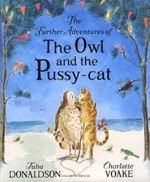 While the newlyweds from Edward Lear’s The Owl and the Pussy-cat slumber in a Bong-Tree, a crow steals the wedding ring tied with a bow to Pussy-cat’s tail. Their adventurous voyage in a beautiful blue balloon to recover the ring is filled with references to places, things, and characters from Lear’s nonsense poems. In Chankly Bore they find the crow, who has sold the ring to the Pobble who has no toes: “So they crossed the sea, and the Jelly Bo Lee, / To the Pobble’s improbable land.” The Pobble is reluctant to part with the ring, so the resourceful couple visit the Calico Doves, “[w]ho flapped in the air while they knitted a pair / Of impeccable gossamer gloves, / Two gloves, / Two gloves, / Two impeccable gossamer gloves.” A swap is made, and the Owl and the Pussy-cat return home to celebrate with friends, including the Jumblies and the Dong with a luminous nose. Extend the fun of this adventure with a reading of The Owl and the Pussy-cat (simultaneously published with Charlotte Voake’s whimsical watercolor-and-ink illustration) and more of Lear’s classic nonsense verses.
While the newlyweds from Edward Lear’s The Owl and the Pussy-cat slumber in a Bong-Tree, a crow steals the wedding ring tied with a bow to Pussy-cat’s tail. Their adventurous voyage in a beautiful blue balloon to recover the ring is filled with references to places, things, and characters from Lear’s nonsense poems. In Chankly Bore they find the crow, who has sold the ring to the Pobble who has no toes: “So they crossed the sea, and the Jelly Bo Lee, / To the Pobble’s improbable land.” The Pobble is reluctant to part with the ring, so the resourceful couple visit the Calico Doves, “[w]ho flapped in the air while they knitted a pair / Of impeccable gossamer gloves, / Two gloves, / Two gloves, / Two impeccable gossamer gloves.” A swap is made, and the Owl and the Pussy-cat return home to celebrate with friends, including the Jumblies and the Dong with a luminous nose. Extend the fun of this adventure with a reading of The Owl and the Pussy-cat (simultaneously published with Charlotte Voake’s whimsical watercolor-and-ink illustration) and more of Lear’s classic nonsense verses.
A Greyhound, a Groundhog. Emily Jenkins. Ill. Chris Appelhans. 2017. Schwartz & Wade/Random House.
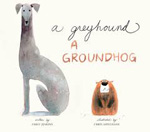 “A hound. / A round hound. / A greyhound. / A hog. / A round hog. / A groundhog.” As the round little greyhound awakes from a nap and the brown little groundhog pops out of his hole, the two begin a romp “around and around and around / and around!” The playfully rhythmic mix-up of words in this tongue-twister of a tale starts out quietly, then speeds up as the greyhound and the groundhog whirl across the pages. “A round hound, / a grey dog, / a round little hound dog. / A greyhog, / a round dog, / a hog little hound dog.” Following a chase of colorful butterflies and a run through a bog, the exhausted new friends settle down side by side for a rest. Chris Applelhans’s full-of-motion watercolor paintings featuring the greyhound and the groundhog at play against expansive white backgrounds perfectly match Emily Jenkins’s clever text in this joyful picture book, which is best shared as a read-aloud.
“A hound. / A round hound. / A greyhound. / A hog. / A round hog. / A groundhog.” As the round little greyhound awakes from a nap and the brown little groundhog pops out of his hole, the two begin a romp “around and around and around / and around!” The playfully rhythmic mix-up of words in this tongue-twister of a tale starts out quietly, then speeds up as the greyhound and the groundhog whirl across the pages. “A round hound, / a grey dog, / a round little hound dog. / A greyhog, / a round dog, / a hog little hound dog.” Following a chase of colorful butterflies and a run through a bog, the exhausted new friends settle down side by side for a rest. Chris Applelhans’s full-of-motion watercolor paintings featuring the greyhound and the groundhog at play against expansive white backgrounds perfectly match Emily Jenkins’s clever text in this joyful picture book, which is best shared as a read-aloud.
Tidy. Emily Gravett. 2017. Simon & Schuster.
 With rhyming text and colorful mixed-media illustrations filled with humorous details, Emily Gravett tells a story with a gentle environmental message about Pete, a badger, whose tidying up of the fauna and flora of his forest home goes too far. He grooms the fox’s fur (using a hedgehog for a brush), spruces up the birds (having them use toothbrushes for beak cleaning and giving them sponge baths), vacuums up fall leaves (creating mountains of black plastic trash bags), and digs up all the trees. Following a flood that leaves a muddy mess, he paves over the forest floor. Not a good solution. Realizing he’s made a mistake, Pete enlists the animals’ help in a forest restoration project: “They put everything back, as it always had been. / (But maybe less ordered and not quite as clean.)” Pete promises to tidy up less, but the final two-page illustration, which shows the animals enjoying a spring picnic, includes a detail suggesting that Pete might not be cured of his tidying-up habit.
With rhyming text and colorful mixed-media illustrations filled with humorous details, Emily Gravett tells a story with a gentle environmental message about Pete, a badger, whose tidying up of the fauna and flora of his forest home goes too far. He grooms the fox’s fur (using a hedgehog for a brush), spruces up the birds (having them use toothbrushes for beak cleaning and giving them sponge baths), vacuums up fall leaves (creating mountains of black plastic trash bags), and digs up all the trees. Following a flood that leaves a muddy mess, he paves over the forest floor. Not a good solution. Realizing he’s made a mistake, Pete enlists the animals’ help in a forest restoration project: “They put everything back, as it always had been. / (But maybe less ordered and not quite as clean.)” Pete promises to tidy up less, but the final two-page illustration, which shows the animals enjoying a spring picnic, includes a detail suggesting that Pete might not be cured of his tidying-up habit.
Uncle Holland. JonArno Lawson. Ill. Natalie Nelson. 2017. Groundwood/House of Anansi.
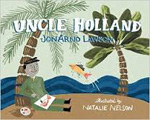 Holland, the eldest of the three Lawson boys, was always getting into trouble. Unable to resist pretty things, he couldn’t help stuffing them into his pockets. When he is caught for the 37th time, the police give him a choice: go to jail or join the army. Holland opts for the army and is sent to a very pretty place in the south, which is full of pretty things—“but not the kinds of things you can put in your pocket.” Holland takes up painting them instead and soon finds he’s making money selling pictures of the extraordinary fish he sees. Natalie Nelson’s digital collage artwork is the perfect match for JonArno Lawson’s story of a choice well made, which is based on a true story about his Uncle Holland.
Holland, the eldest of the three Lawson boys, was always getting into trouble. Unable to resist pretty things, he couldn’t help stuffing them into his pockets. When he is caught for the 37th time, the police give him a choice: go to jail or join the army. Holland opts for the army and is sent to a very pretty place in the south, which is full of pretty things—“but not the kinds of things you can put in your pocket.” Holland takes up painting them instead and soon finds he’s making money selling pictures of the extraordinary fish he sees. Natalie Nelson’s digital collage artwork is the perfect match for JonArno Lawson’s story of a choice well made, which is based on a true story about his Uncle Holland.
Ages 9–11
Harry Miller’s Run. David Almond. Ill. Salvatore Rubbino. 2017. Candlewick.
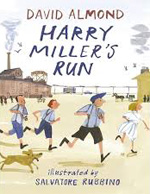 Eleven-year-old Liam just received his official T-shirt for his entry in the Junior Great North Run and is eager for a Saturday morning of training with best friend, Jacksie. His mother, however, wants him to help her clear out elderly neighbor Harry Miller’s house in preparation for his move into a nursing home. Seeing Liam’s T-shirt, Harry begins to relate memories of the 13-mile run he and two mates made from Newcastle to the seaside in South Shields on a hot summer day in 1938, when he was 11. Looking through an old box of photographs helps Harry recall details of the memorable run. David Almond uses a regional British accent in the narration as Harry shares memories and imparts words of wisdom regarding a life well lived—“Me great achievement is that I’ve been happy, that I’ve never been nowt but happy”—before falling asleep in his big chair. Salvatore Rubbino’s expressive mixed-media artwork, with gray-toned paintings for Harry’s day with Liam and his mother and full-color paintings for Harry’s remembrances, perfectly complements this intergenerational story.
Eleven-year-old Liam just received his official T-shirt for his entry in the Junior Great North Run and is eager for a Saturday morning of training with best friend, Jacksie. His mother, however, wants him to help her clear out elderly neighbor Harry Miller’s house in preparation for his move into a nursing home. Seeing Liam’s T-shirt, Harry begins to relate memories of the 13-mile run he and two mates made from Newcastle to the seaside in South Shields on a hot summer day in 1938, when he was 11. Looking through an old box of photographs helps Harry recall details of the memorable run. David Almond uses a regional British accent in the narration as Harry shares memories and imparts words of wisdom regarding a life well lived—“Me great achievement is that I’ve been happy, that I’ve never been nowt but happy”—before falling asleep in his big chair. Salvatore Rubbino’s expressive mixed-media artwork, with gray-toned paintings for Harry’s day with Liam and his mother and full-color paintings for Harry’s remembrances, perfectly complements this intergenerational story.
The Wizard’s Dog. Eric Kahn Gale. Ill. Dave Phillips. 2017. Crown/Random House.
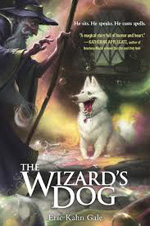 Nosewise, a stray dog rescued by wizard Merlin, is eager to increase his repertoire of tricks beyond Sit! Shake! and Lie down! When Merlin’s apprentice, Morgana, places her magic Asteria stone around his neck, Nosewise is delighted to find that he can Speak! This new trick becomes important when he sets out on a rescue mission after Merlin is kidnapped by Lord Destrian (Oberon, king of the Fae, in a glamour state), who intends to use the wizard to obtain Excalibur. Using his nose, Nosewise, joined by a young Arthur, the “poop boy” (the cleaner of chamber pots in Destrian’s castle), tracks Merlin’s scent from the castle into the Haunted Forest, through a portal into the Otherworld, and eventually to Avalon, where they do battle with Oberon (in his Destrian disguise) and the Fae’s magic-eating worms. In this retelling of the Arthurian legend of the Sword in the Stone, readers learn how Arthur became the rightful king of the human world. A hint: Excalibur can only be taken by “a worthy soul who loves man and would never do him harm.”
Nosewise, a stray dog rescued by wizard Merlin, is eager to increase his repertoire of tricks beyond Sit! Shake! and Lie down! When Merlin’s apprentice, Morgana, places her magic Asteria stone around his neck, Nosewise is delighted to find that he can Speak! This new trick becomes important when he sets out on a rescue mission after Merlin is kidnapped by Lord Destrian (Oberon, king of the Fae, in a glamour state), who intends to use the wizard to obtain Excalibur. Using his nose, Nosewise, joined by a young Arthur, the “poop boy” (the cleaner of chamber pots in Destrian’s castle), tracks Merlin’s scent from the castle into the Haunted Forest, through a portal into the Otherworld, and eventually to Avalon, where they do battle with Oberon (in his Destrian disguise) and the Fae’s magic-eating worms. In this retelling of the Arthurian legend of the Sword in the Stone, readers learn how Arthur became the rightful king of the human world. A hint: Excalibur can only be taken by “a worthy soul who loves man and would never do him harm.”
Ages 12–14
An Eagle in the Snow. Michael Morpurgo. 2017. Feiwel and Friends.
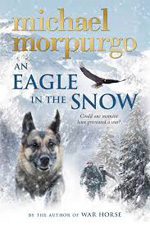 In 1940, 10-year-old Barney and his mother, whose home has just been destroyed in the Coventry blitz, are aboard a London-bound train on the first leg of their journey to Aunt Mavis’s in Cornwall when a stranger enters their compartment. As German planes attack, the train enters a tunnel, abruptly stops, and plunges into darkness. During the long wait for their journey to continue, the stranger calms Barney’s fears of the darkness by telling stories about his friend Billy Byron’s experiences as a soldier in World War I. This courageous young British soldier’s decision not to kill a German soldier with whom he had a face-to-face encounter near the end of the war comes to make him feel responsible, 20 years later, “for whatever Adolf Hitler had done or might do in the future.” He could have stopped him, but hadn’t, at the Battle of Marcoing. In an afterword, Morpurgo provides a brief history of Private Henry Tandey VC, to whom An Eagle in the Snow is dedicated and whose personal story of service in World War I was the inspiration for the book.
In 1940, 10-year-old Barney and his mother, whose home has just been destroyed in the Coventry blitz, are aboard a London-bound train on the first leg of their journey to Aunt Mavis’s in Cornwall when a stranger enters their compartment. As German planes attack, the train enters a tunnel, abruptly stops, and plunges into darkness. During the long wait for their journey to continue, the stranger calms Barney’s fears of the darkness by telling stories about his friend Billy Byron’s experiences as a soldier in World War I. This courageous young British soldier’s decision not to kill a German soldier with whom he had a face-to-face encounter near the end of the war comes to make him feel responsible, 20 years later, “for whatever Adolf Hitler had done or might do in the future.” He could have stopped him, but hadn’t, at the Battle of Marcoing. In an afterword, Morpurgo provides a brief history of Private Henry Tandey VC, to whom An Eagle in the Snow is dedicated and whose personal story of service in World War I was the inspiration for the book.
Flying Lessons & Other Stories. Ellen Oh (Ed.). 2017. Crown/Random House.
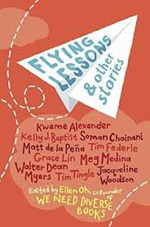 We all need diverse stories, and the short stories in this anthology, written by 10 talented authors (Kwame Alexander, Kelly J. Baptist, Soman Chainani, Matt de la Peña, Tim Federle, Grace Lin, Meg Medina, Walter Dean Myers, Tim Tingle, and Jaqueline Woodson), introduce middle graders to memorable characters who all want to belong and be accepted for who they are. Although the stories stand alone, readers will find that each story draws them to read another. Reading the stories aloud in classrooms and libraries is an excellent way to introduce young people to the We Need Diverse Books movement. The back matter includes an “About We Need Diverse Books” section by Ellen Oh, cofounder and president of WNDB, and brief biographies of the 10 contributors.
We all need diverse stories, and the short stories in this anthology, written by 10 talented authors (Kwame Alexander, Kelly J. Baptist, Soman Chainani, Matt de la Peña, Tim Federle, Grace Lin, Meg Medina, Walter Dean Myers, Tim Tingle, and Jaqueline Woodson), introduce middle graders to memorable characters who all want to belong and be accepted for who they are. Although the stories stand alone, readers will find that each story draws them to read another. Reading the stories aloud in classrooms and libraries is an excellent way to introduce young people to the We Need Diverse Books movement. The back matter includes an “About We Need Diverse Books” section by Ellen Oh, cofounder and president of WNDB, and brief biographies of the 10 contributors.
Ages 15+
Poison’s Kiss. Breeana Shields. 2017. Random House.
 Seventeen-year-old Marinda is an assassin—a visha kanya, or poison maiden—who can kill with a kiss. As a baby, she was repeatedly subjected to being bitten by snakes until she was immune to their venom. Gopal, her handler, has led Miranda to believe that she is using her poisonous kisses as a weapon in service to the Raja by killing the enemies of the kingdom of Sundari. Marinda feels guilty about what she does, and when she is instructed to kiss Deven, a young man who is kind to her and Mani, her sickly 7-year-old brother, she is determined to save Deven's life. Breeana Shields's complex fantasy, which incorporates aspects of Indian culture and mythology, is intriguing. As Marinda learns who turned her into a killer and why, she is eager to destroy them—and readers are set up for a sequel.
Seventeen-year-old Marinda is an assassin—a visha kanya, or poison maiden—who can kill with a kiss. As a baby, she was repeatedly subjected to being bitten by snakes until she was immune to their venom. Gopal, her handler, has led Miranda to believe that she is using her poisonous kisses as a weapon in service to the Raja by killing the enemies of the kingdom of Sundari. Marinda feels guilty about what she does, and when she is instructed to kiss Deven, a young man who is kind to her and Mani, her sickly 7-year-old brother, she is determined to save Deven's life. Breeana Shields's complex fantasy, which incorporates aspects of Indian culture and mythology, is intriguing. As Marinda learns who turned her into a killer and why, she is eager to destroy them—and readers are set up for a sequel.
Carolyn Angus is former director of the George G. Stone Center for Children’s Books, Claremont Graduate University, Claremont, CA.
These reviews are submitted by members of the International Literacy Association's Children's Literature and Reading Special Interest Group (CL/R SIG) and are published weekly on Literacy Daily.